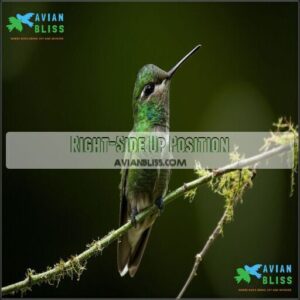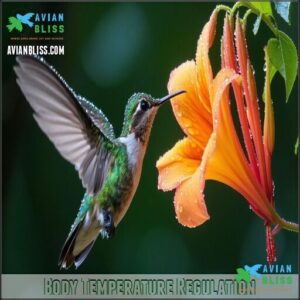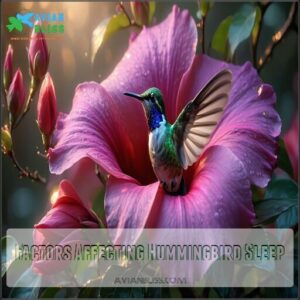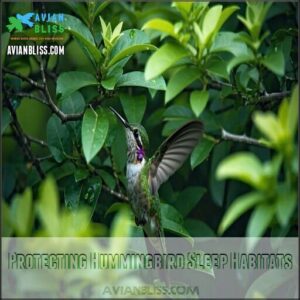This site is supported by our readers. We may earn a commission, at no cost to you, if you purchase through links.
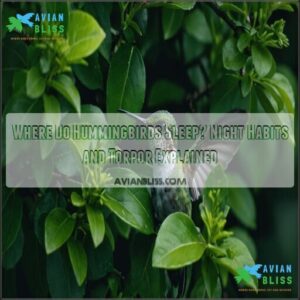
Unlike your power nap, these tiny birds enter a state called torpor—essentially their version of hibernation. During torpor, their metabolism slows dramatically, heart rate drops from 1,200 to just 50 beats per minute, and body temperature plummets from 104°F to near-ambient.
They’ll often hang upside down, looking more like little fuzzy bumps than birds, conserving precious energy their sugar-fueled bodies desperately need.
The fascinating ways these aerial acrobats adapt to nighttime survival reveals nature’s ingenious energy-saving solutions.
Table Of Contents
- Key Takeaways
- Hummingbird Sleep Basics
- Where Hummingbirds Sleep
- Hummingbird Sleeping Positions
- Hummingbird Nighttime Activity
- Factors Affecting Hummingbird Sleep
- Hummingbird Migration and Rest
- Protecting Hummingbird Sleep Habitats
- Frequently Asked Questions (FAQs)
- What is the lifespan of a hummingbird?
- What does it mean when a hummingbird visits you daily?
- Where do hummingbirds roost?
- How do hummingbirds sleep?
- Where do hummingbirds go at night?
- Why is it hard to find sleeping hummingbirds?
- Do hummingbirds need a good night’s sleep?
- Where do hummingbirds sleep in winter?
- Do hummingbirds sleep in the same place every night?
- Where should you not hang a hummingbird feeder?
- Conclusion
Key Takeaways
- You’ll find hummingbirds sleeping in sheltered spots like dense shrubs and tree branches where they’re protected from predators and harsh weather conditions.
- During sleep, hummingbirds enter a state called torpor where their metabolism slows dramatically, heart rate drops from 1,200 to just 50 beats per minute, and body temperature plummets to conserve energy.
- Hummingbirds may sleep hanging upside down or perched upright, often appearing like small fuzzy bumps rather than birds, with their feet locked tightly onto surfaces to stay secure through the night.
- You can help protect sleeping hummingbirds by creating gardens with native flowering shrubs for shelter, reducing outdoor lighting that causes disruption, and minimizing nighttime disturbances around their resting areas.
Hummingbird Sleep Basics
You might think hummingbirds never rest with all that buzzing around, but they actually sleep every night to conserve energy for the next day’s constant feeding.
Their bodies even enter a special state called torpor, slowing down functions like heart rate and metabolism to survive until morning.
Daily Energy Needs
Hummingbirds live life in the fast lane, burning calories like tiny, flying athletes!
They rely on constant nectar consumption and insect intake to fuel their high-energy days.
Every flap of their wings demands serious energy, which they store to survive periods of hummingbird sleep and roosting.
At night, torpor frequency helps conserve energy, a critical strategy for their survival.
Importance of Torpor
Torpor is a game-changer for hummingbird survival.
During sleep, they slow their metabolism drastically, saving up to 60% of energy. Body temperature drops, and their heart rate plummets to conserve resources.
This survival mechanism helps them endure chilly nights, acting like nature’s thermostat. Torpor duration typically lasts all night, ensuring hummingbirds wake refreshed, ready to refuel and face the day.
Physiological Changes During Sleep
When resting, their metabolism slows, turning sleepy hummingbirds into energy savers.
Torpor kicks in, as body temperature drops and heart rate plummets from a racing 1,200 beats to a gentle 50 per minute.
This controlled hibernation minimizes energy expenditure during the night.
Though torpor duration varies, these physiological changes guarantee they’re ready to wake up and refuel at dawn, utilizing their torpor effectively.
Where Hummingbirds Sleep
Finding where hummingbirds sleep is all about safety and strategy. They’re experts at picking safe perches like thin twigs or dense shrubs, keeping them hidden from predators.
Nest locations are prime spots for mothers, while others rotate between torpor spots to suit food sources and weather.
Their habitat selection focuses on camouflage needs, like perching in shaded, wind-sheltered areas.
At night, you might spot a hummingbird roosting in unexpected places, even hanging upside down—don’t worry, it’s just part of their unique sleeping patterns.
To encourage nesting, consider providing sheltered tree branches in your yard.
Hummingbird Sleeping Positions
When hummingbirds sleep, they either perch upright on a branch or, surprisingly, hang upside down like tiny, colorful bats.
Their feet lock tightly onto surfaces, keeping them secure while they rest through the night.
Hanging Upside Down
A hummingbird at night might surprise you by hanging upside down. This upsidedown sleeping can happen due to perch instability, muscle fatigue, or a smooth surface.
It’s often linked to torpor, their energy-saving mode that slows everything down. While startling to see, it’s harmless—an evolutionary advantage for surviving cold nights.
They’ll right themselves at dawn, ready to eat.
Right-Side Up Position
Unlike their occasional upside-down naps, hummingbirds often sleep upright, perched securely on a twig or branch.
Their toes grip tightly, ensuring perch stability, while their feather position fluffs up for warmth. You’ll notice their neck posture angled comfortably, with their bill direction pointed slightly upward.
These bird roosting habits showcase the precision of hummingbird sleep, keeping them safe in their resting spots.
Body Temperature Regulation
During sleep, a hummingbird’s body temperature drops dramatically through torpor, conserving energy.
This process slows their metabolic rate, creating a thermal gradient that limits heat loss.
Feather insulation plays a key role, acting like a cozy blanket against cold nights.
Torpor thresholds depend on climate adaptation, helping these tiny birds balance energy needs while surviving chilly sleeps, even in harsh environments.
Hummingbird Nighttime Activity
At night, hummingbirds are surprisingly inactive, prioritizing rest and energy conservation over anything else. They enter a deep sleep state called torpor, which helps them survive until the next sunrise.
Feeding at Night
Some birds grab a midnight snack, but hummingbirds don’t. Nocturnal feeding isn’t their style—they rely on sunlight to fuel their daytime energy consumption.
Torpor influences this, as their bodies slow down at night for energy conservation. However, artificial feeders often attract nocturnal critters like raccoons or bats.
Bright, warm climates rarely disrupt hummingbird sleeping patterns, keeping their energy-balanced lifestyle intact.
Seasonal changes can also affect bird feeding habits, influencing when and where they seek sustenance.
Influence of Urban Environments
In cities, abundant urban food sources and shelter options affect hummingbird sleeping patterns.
They adapt to fragmented habitats but struggle with light pollution effects and artificial lighting disrupting their nocturnal rest. Resting spots like shrubs or urban bird habitats provide some relief, but urban pesticide use can reduce safety.
Balanced urban environments help preserve their delicate routines.
Urban hummingbirds also face challenges from increased light pollution, which disrupts their migration patterns.
Migration and Nighttime Behavior
As hummingbirds migrate, their sleep changes drastically.
These tiny travelers focus on long distances, often enduring sleep deprivation. Instead of stopping, they rely on nocturnal torpor during colder months for climate adaptation.
Migration patterns push their energy expenditure sky-high, so every nap counts.
Torpor during nighttime helps them conserve resources, preparing for the next day’s journey without exhausting essential energy reserves.
Factors Affecting Hummingbird Sleep
You mightn’t realize it, but hummingbird sleep depends on a surprising mix of factors like lighting, temperature, and food.
These tiny birds adjust their habits to stay safe, conserve energy, and be ready for tomorrow’s endless search for nectar.
They have to be prepared for the next day’s activities, making their sleep patterns quite unique and fascinating.
Artificial Lighting Impact
Bright lights at night can confuse hummingbirds, disrupting their natural torpor and nocturnal habits. Artificial lighting impacts habitat selection and even foraging changes.
To protect them:
- Reduce light pollution near trees and shrubs.
- Turn off unnecessary outdoor lights.
- Use motion-sensor lighting for safety.
- Select warmer, low-impact bulbs to minimize disruption.
Hummingbirds need darkness to thrive.
Weather Effects on Sleep
When the weather shifts, hummingbirds adapt cleverly.
Weather changes? Hummingbirds adjust like pros, finding snug spots and using torpor to outwit temperature drops and stormy nights.
Cold weather triggers torpor, where body temperature and metabolism drop drastically to prevent hypothermia.
Wind exposure and storms push them to find sheltered spots.
Meanwhile, seasonal changes or rising humidity levels can influence their sleeping patterns.
A safe perch protects them, ensuring survival during dramatic temperature impacts or wild storm effects.
Food Availability and Sleep
Food sources directly impact sleep.
Nectar availability, insect consumption, and feeder access can alter energy reserves, pushing hummingbirds to adjust rest patterns.
Without enough food, torpor triggers earlier, slowing metabolism to conserve energy. Think of it as their “power-saving mode.”
Adequate nourishment guarantees smoother nighttime recovery, preparing them for morning feeding frenzies and helping them survive even harsh conditions.
Hummingbird Migration and Rest
When hummingbirds migrate, they cover vast distances, often flying hundreds of miles without stopping to sleep.
To conserve energy for such demanding journeys, they rely on torpor and well-chosen resting spots before and after travel.
They use this strategy to ensure they have enough energy for the entire migration.
Changes in Sleep Patterns
During migration, hummingbirds experience five distinct changes in their sleep patterns.
These tiny travelers adjust their torpor frequency based on energy demands, entering this deep sleep state more often during long journeys.
You’ll notice seasonal variations affect when they rest, with environmental changes forcing adaptations along migration routes.
Their body temperature and metabolism fluctuate differently than when stationary, allowing these remarkable birds to conserve precious energy while maintaining their incredible journey schedule.
They also rely on visual landmarks for navigation during these long flights.
Energy Impact of Migration
The incredible journey of hummingbird migration demands an astonishing energy investment.
During their 2,000-mile flights, these tiny travelers burn through body fat at remarkable rates, requiring them to double their weight before departure.
You’ll find that stopover energy needs dictate their route planning, with climate influence determining fuel consumption patterns.
Their metabolism adapts specifically for these long-distance movements, a delicate balance between energy expenditure and cold weather survival.
Adaptations for Migration
Beyond energy needs, hummingbirds have evolved remarkable adaptations for migration.
They’ll shrink internal organs and nearly double their weight with fat deposits before long journeys. You’ll find some species flying at night to avoid predators and conserve energy.
Their incredible metabolism adapts to high altitudes, while their visual systems help navigate complex migration routes.
During these journeys, they rely on torpor—a hibernation-like state—to dramatically slow metabolism and guarantee survival.
Protecting Hummingbird Sleep Habitats
You’ll help these tiny aerial acrobats get their much-needed beauty rest by preserving dense shrubs and native trees where they seek shelter during their vulnerable torpor state.
Your garden can become a hummingbird sanctuary when you plant thick foliage and minimize nighttime disturbances, giving these remarkable creatures a safe haven to recharge their buzzing wings.
Creating Hummingbird-Friendly Environments
Creating a hummingbird-friendly sleep environment involves more than just hanging feeders.
Plant native flowering shrubs that provide safe perches and natural shelter design. Your hummingbird habitat should include dense foliage where these tiny flyers can rest undisturbed.
Consider adding flowering shrub varieties for enhanced habitat.
Position water sources nearby but keep them separate from areas where predators might lurk.
A well-designed hummingbird garden supports both feeding and sleeping needs with minimal disturbance.
Avoiding Disturbances
Now that you’ve created a welcoming environment, it’s important to minimize disturbances that might interrupt your hummingbirds’ sleep. These tiny creatures need undisturbed rest during their torpor state.
To protect hummingbird nighttime habits, it is crucial to address the factors that might disrupt their sleep.
- Reduce outdoor lighting that contributes to light pollution and disrupts their sleep cycle
- Keep noise to a minimum near their sleeping areas, especially at dusk
- Limit human interaction in garden areas where hummingbirds frequently perch for the night
Preserving Natural Habitats
Several natural habitats essential for hummingbird sleep are disappearing at an alarming rate.
To help preserve these sanctuaries, plant native flora that provides both nectar and shelter. Creating habitat corridors between green spaces helps maintain their travel routes, while reducing pesticide use protects their food sources.
Remember, water conservation supports the ecosystems where these tiny creatures rest. Consider monitoring bird populations through citizen science.
Your backyard can become a vital nesting sanctuary, supporting hummingbird conservation through thoughtful landscape choices.
Frequently Asked Questions (FAQs)
What is the lifespan of a hummingbird?
You’ll find that most hummingbirds live 3-5 years in the wild, though they can reach 12 years with luck. In captivity, they’ll often survive longer, up to 14 years with proper care.
What does it mean when a hummingbird visits you daily?
When a hummingbird visits you daily, it’s recognizing your yard as a reliable food source.
You’ve created a safe, attractive habitat that’s now part of its regular feeding route.
It’s not personally attached to you.
Where do hummingbirds roost?
You’ll find hummingbirds roosting on thin twigs in dense vegetation, often sheltered from wind and predators.
They’ll sometimes sleep in nests, on branches surrounded by foliage, or occasionally hanging upside down like tiny sleepy bats, showcasing their ability to find rest in various dense locations.
How do hummingbirds sleep?
You’ll find these tiny birds enter torpor, a hibernation-like state, at night.
They’ll perch on sheltered twigs with feathers fluffed, sometimes hanging upside down, while their metabolism and heart rate dramatically slow to conserve energy.
Where do hummingbirds go at night?
At night, you’ll find hummingbirds resting on thin twigs in dense vegetation, sheltered from wind and predators. They’ll enter torpor, a deep sleep-like state, often with their beaks pointed upward.
Why is it hard to find sleeping hummingbirds?
It’s challenging to spot these tiny birds while they rest because they’re tucked away in dense foliage, perfectly camouflaged.
They enter torpor—a deep sleep state that makes them nearly motionless until dawn.
Do hummingbirds need a good night’s sleep?
Yes, hummingbirds absolutely need their rest.
They enter a state called torpor while sleeping, which dramatically slows their metabolism and conserves energy.
This helps these tiny powerhouses recharge for tomorrow’s feeding frenzy.
Where do hummingbirds sleep in winter?
Nearly 90% of North American hummingbirds migrate south for winter.
You’ll find the rest in sheltered spots like dense shrubs, where they’ll enter torpor—a hibernation-like state that drops their heart rate from 1,200 to just 50 beats per minute.
Do hummingbirds sleep in the same place every night?
Hummingbirds don’t always sleep in identical locations each night.
You’ll find they rotate between several favorite perches depending on food sources, weather conditions, and predator presence.
Though they prefer sheltered spots with dense vegetation.
Where should you not hang a hummingbird feeder?
You shouldn’t hang a hummingbird feeder in direct sunlight, near windows, in windy spots, close to ant colonies, in high-traffic areas, or where cats can reach them.
Safety matters for your tiny visitors!
Conclusion
Like tiny magicians of the night, hummingbirds have mastered the art of survival through sleep.
Now you know where hummingbirds sleep—tucked away in sheltered spots, often hanging upside down in torpor’s energy-saving embrace.
By understanding their nighttime habits, you’re better equipped to protect these remarkable creatures. Next time you spot a hummingbird at dusk, imagine its incredible transformation as it prepares for the night’s rest, conserving energy for tomorrow’s aerial feats.
- https://www.theguardian.com/science/punctuated-equilibrium/2006/apr/09/hummingbirds-survive-cold-nights
- https://www.lib.niu.edu/2000/oi000811.html
- https://journeynorth.org/tm/humm/facts_characteristics.html
- https://www.researchgate.net/publication/247260686_Torpor_and_metabolism_in_hummingbirds
- https://scroll.in/video/939536/watch-it-needs-the-fastest-known-muscle-contraction-in-vertebrae-to-make-the-manakin-bird-sing



